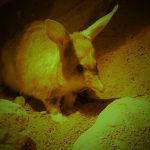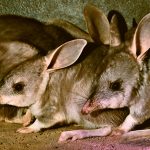BILBY
The Bilby is a small to medium-sized marsupial native to Australia. It belongs to the family Thylacomyidae, also known as rabbit-bandicoots.
Bilbies have unique physical features that make them well-adapted to their arid habitats. They have a long snout, large hairless ears, and powerful hind legs, which aid in their digging abilities. They also possess a prehensile tail, used for carrying nesting material. The fur on their body varies in color from grey to tan, with a white underbelly.
Historically, bilbies were found throughout most of Australia. However, due to habitat destruction, predation from introduced species such as cats, dogs and foxes, and other threats, their range has significantly decreased. Today, they are mainly confined to remote desert regions and arid grasslands of Western Australia, the Northern Territory, and Queensland, sadly they are presumed extinct in NSW.
Bilbies are primarily nocturnal animals, spending their days in burrows to avoid the scorching heat. They are omnivorous creatures with a diverse diet. Their food includes insects, spiders, small reptiles, seeds, bulbs, and fungi. With their strong claws and snout, they are skilled diggers, excavating burrows up to several meters long, which also helps them find food.
The Bilby population has experienced a significant decline over the years, leading to their classification as a vulnerable species by the International Union for Conservation of Nature (IUCN). Several conservation efforts have been undertaken to protect them, including captive breeding programs and habitat restoration initiatives.
Bilbies hold cultural significance for some Aboriginal Australian communities. In recent years, they have also become a symbol of Easter in Australia as an alternative to the introduced species, the European rabbit. “Bilby Easter” aims to raise awareness and support conservation efforts for this unique marsupial. The situation of bilbies highlights the importance of protecting Australia’s unique and diverse wildlife.









